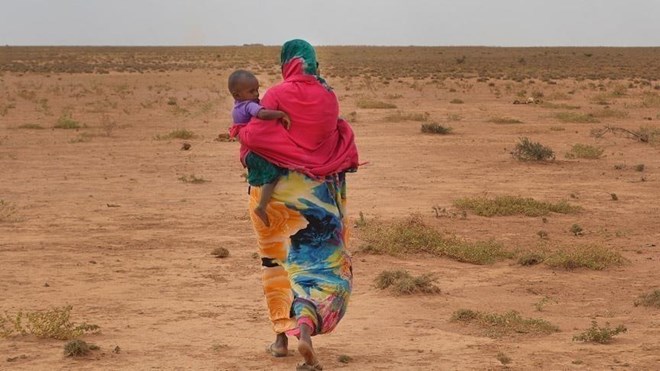
Monday April 4, 2022

Thousands of residents in Somalia have started to flee their
villages in search of a better life after three consecutive years without
enough rainfall because of climate change.
When Ibrahim Abdiyow fled Diinsoor in the Baay region, the
drought was not as devastating as it is now.
He said community members lost all of their livelihoods due
to the magnitude of destruction caused by drought.
"I did not have camels that can live weeks without
drinking enough water. I used to have goats and cattle, when all the wells
dried out and grasslands devastated, I fled to Bardhere to get a job but that
is not the case now because the town is overcrowded by internally displaced
persons who don't have water, shelter and toilets," he told Anadolu
Agency.
Abdiyow is not the only one who fled villages to go to the
Bardhere district in the Gedo region of Somalia's southern state of Jubaland.
Suuban Abdi fled the Diinsoor district in the Baay region
and said that after walking long distances by foot while carrying her children,
they finally arrived at an internally displaced persons (IDP) camp on the
outskirts of Bardhere, with some residents believing one day they might get
help.
She does not know what climate change is but if it is
something related or has contributed to current conditions, she said, it is
something no one should not underestimate.
"I have been here in this camp with my kids hoping they
will be able to live a better life than the one they had in our villages back
in the days, but I realized that the situation is worse but we must be in high
spirit and pray for our kids to have a better future which is uncertain
now," she said.
Locust infestation, floods, droughts
Safiyo Mohamed, an elderly woman, has been in the camp for
the last three months.
"I have lost all my livestock, my livelihood. For the
last three years, there has been crop failure in our villages and our animals
weren’t able to eat. Then, diseases struck, resulting in the deaths of our
sources of income,” she said.
Somalia is one of the countries with the lowest CO2
emissions per inhabitant countries. However, for years, it has been battling to
curb locust infestation, floods and droughts.
The country’s commitment to tackle climate change has been
registered internationally and in 2015 it registered its Intended Nationally
Determined Contribution (NDC) – a formal statement of plans to reduce emissions
and adapt to the effects of climate change under the global Paris Agreement,
according to a statement by United Nations Development Program (UNDP) last
year.
The plan examines agriculture, water, energy, waste and
forest sectors with binding targets, including an overall goal to reduce
greenhouse gas emissions by 30% by 2030 relative to a business-as-usual
trajectory, with international financial and technical support, according to
the UNDP.
Somalia also has commitments to an unconditional goal of
reducing net greenhouse gas emissions by 5% to 10% by 2030 using its resources.
‘Something needs to
be done’
While Somalia’s emissions are historically extremely low, it
represents a significant target given the country’s extremely challenging
circumstances and constrained resources.
Young environmentalist Abdirahman Ismail told Anadolu Agency
that when he considers the current environmental degradation in the Horn of
Africa, he realizes that “something needs to be done.”
He said deforestation has more than doubled in the last
decade and it "has to stop now or never because too late means to destroy
our oxygen."
In Kismayo, an area devastated by environmental degradation
because of its proximity to the Kismayo port, some residents cut trees to make
charcoal to trade.
"It is disheartening and unbelievable that the
government has not done more to stop this," said Ismail.
Mukhtar Mohamed Yusuf told Anadolu Agency that he has a big
family which fled Turdho and is currently living in an IDP camp on the
outskirts of Kismayo, the administrative capital of Jubaland state.
He said he decided to flee after rainfall did not come for
years and his animals died because of environmental hazards.
“I am a family man, fleeing was not an option but did it to
save the lives of my children. It was a difficult decision to come here because
we knew the situation will not be friendly in the first place," he told
Anadolu Agency.